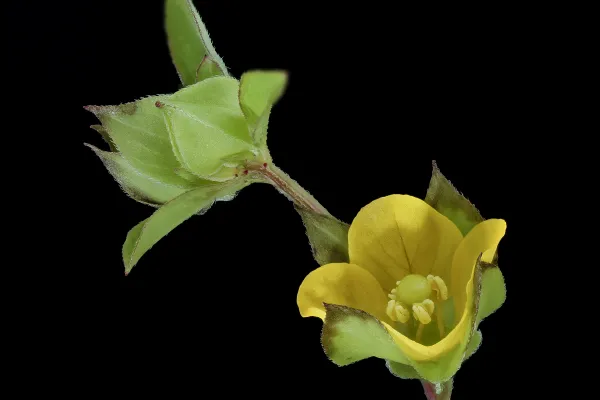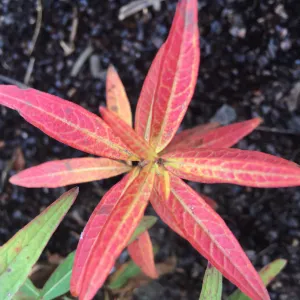Plant Pick: Ludwigia alternifolia
Leaflet 2020

Published June 6, 2021
At first glance one might think it a weed, but Ludwigia alternifolia L., a member of the evening primrose family (Onagraceae), is not without merit. In autumn, it displays fantastic red foliage. It is stunning. Those who lean in for a closer look are rewarded with the sight of its four-angled fruit, a 1⁄4 inch square capsule with a single apical pore from which, when ripe, miniscule, light brown seeds will rain down, perhaps sounding like a tiny rattle. The capsule is a perfect prototype for simple salt and pepper shakers. It is this feature that gives Ludwigia alternifolia the common name seedbox, square-pod, or rattlebox.

But don’t let the small, delicate seed pods fool you. Ludwigia alternifolia has tenacious tuberous roots that help it persist even in tough growing conditions. Here in the botanic garden, Ludwigia alternifolia withstands the horticulturally challenging beds in the Systematics Garden. Most of the area of campus south of Lyman Plant House is underlain by several feet of glacial lake clay, which prevents good drainage. Seedbox thrives in wetter soils, however, as it occurs naturally in wetland edges in full sun to light shade.
Ludwigia alternifolia is found extensively throughout the central and eastern United States and eastern Canada. While New Englanders may not be familiar with Ludwigia alternifolia, they may recognize other showy members of the Onagraceae like Fuchsia, Clarkia (clarkia), and Epilobium (willow herb or fireweed).

Ludwigia is an upright herbaceous plant reaching 2 to 3 feet tall. The narrow leaves are 4 inches long, alternate (as implied by the specific epithet of the species, “alternifolia”), and often found with red petioles and red stems. The yellow flowers bloom singly in the upper leaf axils from mid to late summer. Each flower might reach 1 inch wide, consisting of four petals lasting for about a min- ute, longer on windless days. The four sepals turn red after the flowers open, long before the foliage turns in the fall.
Sometimes a closer look improves our appreciation and rewards our curiosity. Ludwigia alternifolia is an understated native plant that will reward close observation with constant color changes.